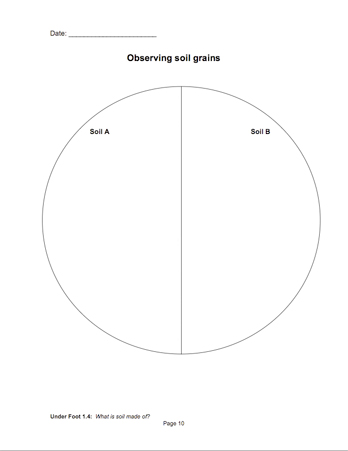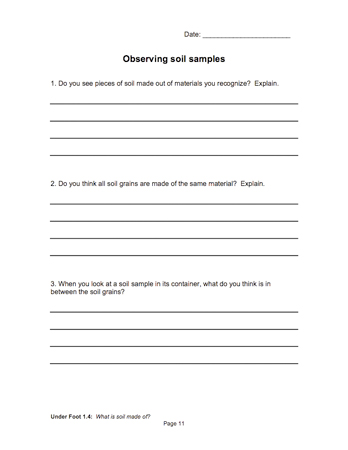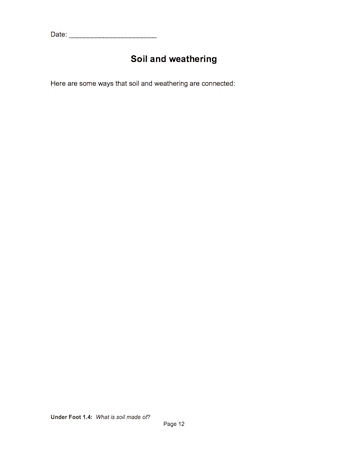What is soil made of?
Plan Investigation 1.4
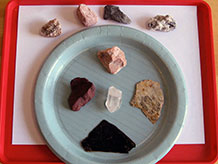
If you scoop up a shovel full of soil on Cape Cod, it will be full of sand. Scoop it up in Georgia, and it will be full of clay. Your backyard soil may have bits of leaves and grass in it. Everywhere you go, soil has its own character — but it’s all soil. Is there a way to think about soil no matter where we find it?
Formative Assessment
Available online at inquiryproject.terc.edu
In this investigation, students observe two soil samples, one sandy and one more organic, and then compare their properties in a Venn diagram. They try to identify components of the soils, and consider the "empty" spaces between grains. They ponder where soil comes from and learn about weathering.
By the end of this investigation, students will understand that all soils are made up of small grains of minerals and or organic matter; and the spaces between the grains, hold air and or water.
Learning Goals
- Identify the components of soils
- Understand the meaning of parent material and organic matter
| Sequence of experiences | ||
|---|---|---|
| 1. Ask the question | Small Groups | 5 Mins |
| 2. Explore the soil samples | Small Groups | 15 Mins |
| 3. Share the data | All Class | 10 Mins |
| 4. Make meaning | Discussion | 15 Mins |
Materials and Preparation
The two soil samples: The kit material labeled "organic soil" already includes a mix of organic and mineral components. Adding sand to the soil increases the mineral content, creating a contrasting soil type for students to investigate.
Prepare two types of soil mix:
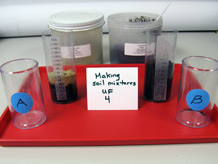
- Mix approximately 200cc of organic soil with approximately 100cc of sand. Put approximately 50cc of the mix into 6 capped containers; label these "A."
- Put approximately 50cc of the organic soil into each of 6 capped containers; label these "B."
For the class:
- Post the investigation question in a place where all students can see it.
- Prepare a large, blank Venn diagram for recording students' data; an example appears in Step 3.
For each tray:
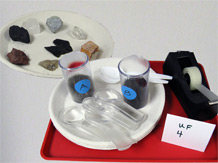
- 1 container of the sandy soil mix "A"
- 1 container of the organic soil "B"
- 1 plate with 8 mineral samples: quartz, mica, biotite, feldspar, halite, hematite, talc, and graphite; this set of minerals was also used in the last investigation
- clear tape
- 2 spoons
- 4 magnifying glasses
- 4 plates
Do students recognize these components of soil: minerals, organic matter and spaces filled with air or water?
As you look for evidence in students’ notebook entries, these questions can help you interpret their writing. Do students:
- recognize that there are spaces between the soil grains, filled with air or water?
- understand that these spaces are important components of soil?
When some of her students had difficulty imagining air spaces in a container of soil, here’s the next step one teacher took.
1. Ask the question
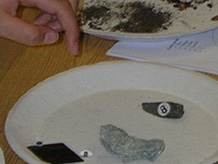
Show students a container of soil and ask if they recognize the contents. Affirm that it is dirt — or as scientists say: soil — and that it’s a very important earth material.
- How would Earth be different if it was just solid rock, if there were no soil?
- no land plants
- no life on land
As students consider the importance of soil, introduce the investigation question.
What is soil made of?
Let students brainstorm some ideas, supporting questions might include
- Where does soil come from?
- Are rocks or minerals involved?
- Is the soil in your backyard the same as the soil in the desert?
- If you dig a hole a foot deep, is the soil at the top the same as the soil at the bottom?
Continue the discussion until a consensus emerges that soil is not a single material, but some combination of materials that appear in very small pieces, and that soils differ from place to place.
Recall the last two investigations, when students observed rocks and minerals using their senses and their magnifiers. Let students know that today they will observe two soil samples, record their observations, and consider what soil might be made of.
2. Explore the soil samples

Distribute the trays of materials. Have each student take a plate, draw a line down the center, and label the two halves "Soil A" and "Soil B," as shown in the notebook [Observing soil grains], then sprinkle a small amount of each soil sample onto the appropriate side of the plate.
Let students know that the tiny particles of material they see in the soil are called "soil grains," then issue a challenge.
- You have two kinds of soil on your plate. How is one different from the other? What are their properties? What kinds of materials are they made of?
Students may work in pairs if they wish.
What to do with the tape? The tape can be used to isolate some small soil grains for close observation. Just press a short piece of tape onto some of the grains on the plate, lift the tape, and use a magnifier to examine the individual grains.
As your circulate among the students, see how many properties they can come up with on their own. If necessary, mention some other properties that might help them determine what soil is made of, e.g., color, smell, size, shape, and luster. Confirm that students see some organic matter in the soils, e.g. bits of leaves, sticks, and bark. Make sure students are recording both their observations and their ideas in their notebooks.
As the pace of data collection slows, have students answer the three questions in their notebooks [Observing soil samples].
3. Share the data
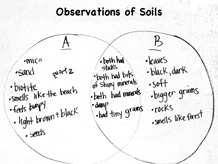
Ask students to share their observations, and as they do, represent them in the large Venn diagram. Let the students decide whether an observation is particular to soil "A," particular to soil "B," or shared by both.
Help students to develop good data recording practices by asking that they read their observations directly from their notebooks.
Do not try to resolve seemingly contradictory data at this time. Instead, record all the students’ observations.
4. Make meaning
Purpose of the discussion
The purpose of the discussion is to elicit students' ideas about soil now that they've made observation, and to encourage them to support their ideas with evidence from their observations. Return to the investigation question for the discussion.
Engage students in the focus question
Begin by reviewing the class observations. Have students raise any questions or comment on what they noticed in the data.
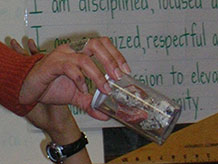
Return to the investigation question:
What ideas do you have now about what soil is made of? Not just these two soils, but all soils?
Students might suggest that soil is a mixture of different sized pieces of rock. Or that soil contains plant material. Or that soil contains minerals. Ask them to support their claims, citing evidence from their own or class data.
- What is between the bits of mineral and plant material in the soil?
Students may be puzzled by the question. They may say there is "nothing" there; "just air" or "empty space." Affirm that the students are correct, and that the empty places are a very important part of the soil. The empty places hold air and water, which allow plants to grow.
There remains one last question:
- Where do you think the soil grains come from?
Examples of weathering actions: Weathering can happen as water flowing in a river bangs rocks against each another, chipping off pieces. Or as the tide rolls rocks and shells up and down the beach every day. Or as acid rain dissolves some of the minerals in rocks, causing pieces to break off.
Let students brainstorm some ideas, making claims and supporting them as best they can with their data, e.g. “I see little bits of quartz in the soil. I think a big piece got pulverized somehow.” Or, “Soil B smells like the woods. I think there are rotten leaves in this soil.”
Introduce the term "weathering." Explain that weathering is the natural process by which larger formations or pieces of rock and mineral break down into smaller pieces through the actions of water, wind, ice, expanding roots, and other forces. It’s the weathering of rocks and minerals and the decomposition of plants and animals that create new soil grains. Those rocks, minerals, plants, and animals are called the parent materials of the soil.
Students may read the information sheet Weathering found in the back of the student notebook. They might also write about soil and weathering in their notebook [Soil and weathering].
Summarize the discussion and recap the investigation
As you summarize the discussion, reinforce these two big ideas:
- Soils are made up of minerals and organic matter, and include spaces between the soil grains that hold air and water.
- Soils come from parent materials that break down through processes of weathering and decomposition.


